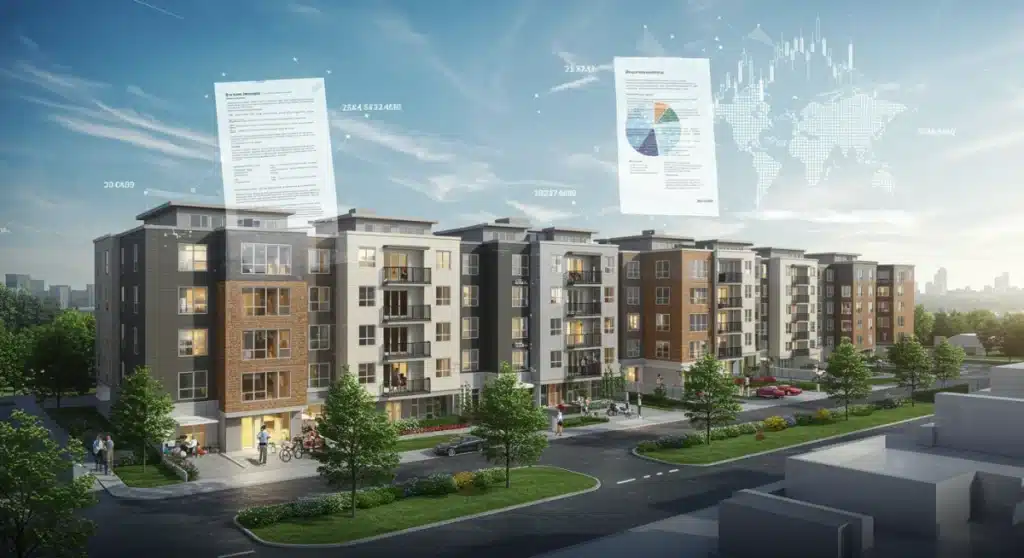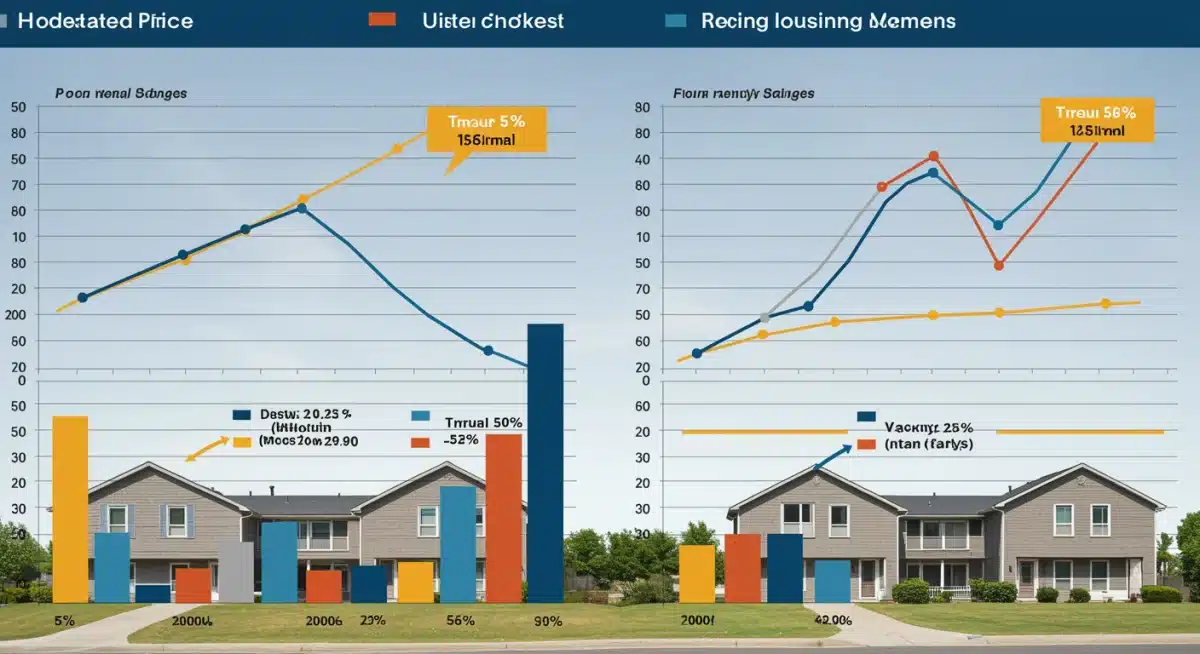2025 Federal Housing Policy: Rental Market Impact

Breaking news reveals that the forthcoming 2025 Federal Housing Policy Adjustments are set to significantly reshape rental markets, with projections indicating a potential 5% impact on housing costs and availability. This development has immediate implications for renters, landlords, and investors nationwide.
Understanding the 2025 Federal Housing Policy Adjustments
The Biden administration, through the Department of Housing and Urban Development (HUD), is preparing to roll out a series of comprehensive housing policy adjustments slated for early 2025. These changes aim to address long-standing issues of housing affordability, supply shortages, and equitable access. The overarching goal is to stabilize the housing market while simultaneously increasing the availability of affordable rental units, directly influencing how the 2025 Federal Housing Policy Adjustments will impact rental markets by 5%.
Sources within HUD indicate that these adjustments are the culmination of extensive research and public feedback, seeking to create a more resilient and fair housing ecosystem. The policies encompass a range of initiatives, from revised funding mechanisms for affordable housing projects to new regulations governing landlord-tenant relations and zoning practices. The anticipated 5% shift in rental markets is a key projection, reflecting the expected magnitude of these changes.
Key Policy Pillars Introduced
The upcoming federal housing policy adjustments are built upon several foundational pillars designed to tackle the multifaceted challenges within the rental sector. These pillars represent a strategic approach to rebalance the market and ensure broader access to stable housing.
- Increased Funding for Affordable Housing: Significant allocations are expected for programs like the National Housing Trust Fund and Low-Income Housing Tax Credits, aiming to stimulate the construction and rehabilitation of affordable rental properties.
- Zoning Reform Incentives: The federal government plans to offer grants and technical assistance to local jurisdictions that implement zoning reforms, encouraging denser housing development and reducing exclusionary zoning practices.
- Enhanced Tenant Protections: New guidelines are anticipated to bolster tenant rights, potentially including clearer eviction moratorium protocols and regulations against predatory rental practices.
- Support for First-Time Homebuyers: While primarily focused on rentals, some policies indirectly support the rental market by easing pathways to homeownership, which can free up rental units.
Projected 5% Shift in Rental Market Dynamics
Economists and housing analysts are closely watching the impending 2025 Federal Housing Policy Adjustments, with many forecasting a notable 5% shift in rental market dynamics. This projection, while an average, could manifest differently across various regions and housing segments. The changes are expected to influence rental prices, vacancy rates, and the overall supply-demand balance in significant ways.
The 5% adjustment is not a uniform increase or decrease but rather a complex interplay of factors. In some areas, increased supply from new affordable housing initiatives might temper rent hikes, while in others, stricter regulations could indirectly affect landlord operating costs, potentially leading to slight upward pressure on rents. The market’s response will largely depend on the specific implementation details and the existing local housing conditions.
Regional Variations in Impact
The 5% projected impact on rental markets is an aggregate figure, and it is crucial to recognize that the effects will vary considerably by region. Urban centers with high demand and limited supply may experience different outcomes compared to suburban or rural areas.
For instance, cities with already stringent zoning laws that resist reform might see less immediate change in supply, potentially leading to continued rent increases despite federal efforts. Conversely, areas that embrace the federal incentives for denser development could experience a more significant stabilization or even reduction in rental costs. This regional disparity highlights the complex nature of national policy implementation.
Impact on Landlords and Property Owners
The 2025 Federal Housing Policy Adjustments will undoubtedly bring new challenges and opportunities for landlords and property owners. The proposed changes, particularly those related to tenant protections and funding for affordable housing, require a proactive approach to compliance and strategy adaptation. Understanding how the 2025 Federal Housing Policy Adjustments will impact rental markets by 5% is crucial for their long-term planning.
New regulations concerning eviction processes, lease agreements, and maintenance standards could necessitate updates to existing operational procedures. Additionally, incentives for developing or converting properties into affordable housing units might open new avenues for investment and revenue streams for owners willing to participate in federal programs. Adapting to these shifts will be key to maintaining profitability and compliance.

Navigating New Regulatory Landscapes
Landlords and property managers will need to stay abreast of the evolving regulatory landscape to ensure compliance and avoid potential penalties. The federal government’s push for enhanced tenant protections means a closer look at existing lease agreements and eviction protocols.
- Lease Agreement Revisions: Expect mandates for clearer, more standardized lease terms, particularly regarding rent increases, maintenance responsibilities, and tenant rights.
- Eviction Process Updates: Federal guidelines may introduce stricter requirements for notice periods and provide more resources for mediation, potentially lengthening the eviction process.
- Maintenance and Safety Standards: Increased scrutiny on property conditions could lead to higher compliance costs for ensuring units meet federal safety and habitability standards.
Implications for Renters and Housing Affordability
For millions of renters across the United States, the 2025 Federal Housing Policy Adjustments offer a mixed bag of potential outcomes. The primary aim of these policies is to improve housing affordability and access, yet the immediate impact could vary. Understanding how the 2025 Federal Housing Policy Adjustments will impact rental markets by 5% is paramount for individuals seeking stable housing.
Increased supply of affordable units, coupled with enhanced tenant protections, could lead to more stable and equitable rental experiences. However, any indirect cost increases for landlords might, in some cases, be passed on to tenants, mitigating some of the intended benefits. The effectiveness of these policies will largely depend on their ability to significantly expand the housing stock in high-demand areas.
Potential Benefits and Challenges for Tenants
Tenants could see several benefits from the new policies, including more transparent rental practices and greater protection against unfair evictions. The focus on increasing affordable housing stock is also a positive development for those struggling with high rental costs.
However, challenges may arise during the transition period. For instance, while new construction is encouraged, it takes time for new units to come online, meaning immediate relief might not be widespread. Additionally, navigating new regulations and understanding their rights will require renters to be informed and proactive.
Broader Economic Repercussions
The 2025 Federal Housing Policy Adjustments are not just about housing; they carry broader economic repercussions that could ripple through various sectors. A 5% adjustment in rental markets, whether upward or downward in specific segments, affects consumer spending, local economies, and even labor mobility. The magnitude of how the 2025 Federal Housing Policy Adjustments will impact rental markets by 5% extends beyond just housing costs.
For example, if housing becomes more affordable in certain regions, residents might have more disposable income, boosting local retail and services. Conversely, if rental costs continue to climb in some areas due to unforeseen policy effects, it could strain household budgets, leading to reduced consumer spending and potential economic slowdowns in those localities. The construction sector is also poised for significant activity due to increased funding for new housing projects.
Impact on Local Economies and Businesses
Local economies are intrinsically linked to housing affordability. When housing costs are manageable, businesses benefit from a stable workforce and increased local spending. The federal housing policies aim to foster this stability.
- Increased Consumer Spending: More affordable housing frees up household income for other goods and services, stimulating local businesses.
- Workforce Stability: Accessible housing helps businesses attract and retain employees, reducing turnover and improving productivity.
- Construction Boom: New housing initiatives will likely spur job growth in the construction and related industries, injecting capital into local economies.
- Real Estate Market Adjustments: The policies could lead to a re-evaluation of property values and investment opportunities, affecting local real estate markets.
Preparing for the 2025 Policy Rollout
As the 2025 Federal Housing Policy Adjustments draw nearer, the focus shifts to their practical implementation and the real-world impact on rental markets. Stakeholders, from individual renters to large property management firms, must remain vigilant and adaptable. The coming months will likely bring more detailed guidance from HUD, alongside local and state-level responses to these federal mandates. Continued monitoring of legislative developments and market trends will be critical for navigating this evolving landscape effectively and understanding the full scope of how the 2025 Federal Housing Policy Adjustments will impact rental markets by 5%.
Actionable Steps for Stakeholders
Proactive engagement and strategic planning are essential for navigating the forthcoming policy changes. Various stakeholders have specific actions they can take to prepare for the 2025 rollout.
- For Landlords: Conduct a thorough review of lease agreements, update eviction protocols to align with new federal guidelines, and explore eligibility for affordable housing development incentives.
- For Renters: Familiarize yourselves with proposed tenant protections, understand new avenues for rental assistance, and research local affordable housing programs.
- For Developers: Investigate federal grants and tax credits for affordable housing projects, engage with local planning departments on zoning reform initiatives, and assess market demand for various housing types.
- For Local Governments: Evaluate current zoning ordinances for potential reforms, collaborate with federal agencies on housing initiatives, and prepare to implement new tenant protection measures.
| Key Point | Brief Description |
|---|---|
| Policy Adjustments | Comprehensive changes from HUD targeting affordability and supply. |
| Rental Market Impact | Projected 5% shift in rental prices and vacancy rates across regions. |
| Landlord Considerations | New regulations on tenant protections and opportunities in affordable housing. |
| Renter Benefits | Potential for increased affordability and stronger tenant rights. |
Frequently Asked Questions About 2025 Housing Policy
The main goals are to enhance housing affordability, increase the supply of rental units, and ensure more equitable access to housing. These adjustments aim to stabilize the rental market and support vulnerable populations, directly influencing how the 2025 Federal Housing Policy Adjustments will impact rental markets by 5%.
While a 5% overall market shift is projected, regional impacts will vary. Areas with new affordable housing developments might see stabilized or reduced rents, whereas other regions could experience slight increases due to indirect operational costs for landlords. The specific local conditions will dictate the precise outcome.
Expected tenant protections include clearer guidelines for eviction moratoriums, fairer lease agreement terms, and enhanced regulations against predatory rental practices. These measures aim to provide greater security and rights for renters nationwide, directly addressing how the 2025 Federal Housing Policy Adjustments will impact rental markets by 5%.
Yes, the federal government plans to offer incentives, such as grants and tax credits, to landlords and developers who participate in affordable housing programs or implement zoning reforms. These incentives aim to encourage compliance and expand the supply of affordable units.
The policies are slated for rollout in early 2025. However, full implementation and observable market impacts, including the projected 5% shift, may take several months as local jurisdictions adapt and new housing projects get underway. Stakeholders should monitor official announcements.
What Happens Next
As the 2025 Federal Housing Policy Adjustments draw closer, the focus shifts to their practical implementation and the real-world impact on rental markets. Stakeholders, from individual renters to large property management firms, must remain vigilant and adaptable. The coming months will likely bring more detailed guidance from HUD, alongside local and state-level responses to these federal mandates. Continued monitoring of legislative developments and market trends will be critical for navigating this evolving landscape effectively and understanding the full scope of how the 2025 Federal Housing Policy Adjustments will impact rental markets by 5%.





